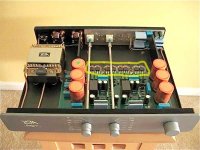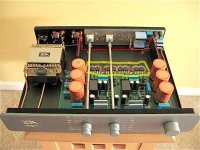Hello Forum:
I have a picture of the internals of a YBA Integre.
From looking at it from my inexperience, I don't recognize a transistor output section or heat-sinks - although I am sure that there are
Could someone comment on the internals and perhaps the over-all design and sonic qualities?
An externally hosted image should be here but it was not working when we last tested it.
I have a picture of the internals of a YBA Integre.
From looking at it from my inexperience, I don't recognize a transistor output section or heat-sinks - although I am sure that there are
Could someone comment on the internals and perhaps the over-all design and sonic qualities?
From looking at it from my inexperience, I don't recognize a transistor output section or heat-sinks
Output devices hi-lited. Chassis is the heat-sink
dave
Attachments
[FONT=Arial, Helvetica, sans-serif]Thanks to all for drawing those sections for me, such excellent help on this site!
I'm going to do some more search on this unit, but so far it is stated to put out:
50 watts at 8 ohms and [FONT=Arial, Helvetica, sans-serif]90 watts at 4 ohms using Class Alpha Amplification.
Is Class Alpha similar to or the same as Class A?
It would seem a rather small heat sink assembly for Class A...no?
Also, this unit is five years old and spent its life on the east coast of Florida - although in an air conditioned home. Is this a possible issue with the components?
[/FONT]
[/FONT]
I'm going to do some more search on this unit, but so far it is stated to put out:
50 watts at 8 ohms and [FONT=Arial, Helvetica, sans-serif]90 watts at 4 ohms using Class Alpha Amplification.
Is Class Alpha similar to or the same as Class A?
It would seem a rather small heat sink assembly for Class A...no?
Also, this unit is five years old and spent its life on the east coast of Florida - although in an air conditioned home. Is this a possible issue with the components?
[/FONT]
[/FONT]
Last edited:
can be an issue ...but looking at the all set up size of trafo cooling facilities it doesnt look like real Class A equipment ...
it is probably a normal class AB amplifier only instead of 30-50ma that is the normal bias for a comercial amplifier this one is probably biased at 120-300 ma to come closer to class A but not pure class A
that doesnt mean that this a bad amplifier on the contrary it can be a very nice amp ...looking ata the quality of material and the quality of built i think that is a superb piece of equipment
regards sakis
it is probably a normal class AB amplifier only instead of 30-50ma that is the normal bias for a comercial amplifier this one is probably biased at 120-300 ma to come closer to class A but not pure class A
that doesnt mean that this a bad amplifier on the contrary it can be a very nice amp ...looking ata the quality of material and the quality of built i think that is a superb piece of equipment
regards sakis
50 watts in pure Class A would require a much much larger heatsink and PSU.
It's probably some "marketing speak" for a sliding bias class ab or something like that.
Amplifier classes are well defined... either it is or it isn't
Just out of interest what are the device numbers on the output transistors ?
It's probably some "marketing speak" for a sliding bias class ab or something like that.
Amplifier classes are well defined... either it is or it isn't
Just out of interest what are the device numbers on the output transistors ?
50 watts in pure Class A would require a much much larger heatsink and PSU.
It's probably some "marketing speak" for a sliding bias class ab or something like that.
Amplifier classes are well defined... either it is or it isn't
Just out of interest what are the device numbers on the output transistors ?
I don't know what the device numbers for output transistors are. I might be able to find out and will reply.
I don't know what the device numbers for output transistors are. I might be able to find out and will reply.
Don't worry... I only meant the numbers printed on the top of the those transistors on the heatsink.
Sometimes manufacturers rub them out and paint them over.
They don't like you knowing they used TIP3055 etc
Output devices hi-lited. Chassis is the heat-sink
dave
great similarity to Densen's integrated amps:
http://www.diyaudio.com/forums/solid-state/114865-densen-amp.html
for normal home hifi applications in Class AB enough (idle current <100mA/channel).
Are there schematics from this YBA model?
Last edited:
Yes, the transistors have been masked. I don't have a clue as to acquiring schematics... perhaps someone here may. I am interested in this unit as a purchase, but just discovered that a newer model released about 4 years ago offering dual transformers. Some people here as well, other sites have expressed their believes about the disadvantages of dual. Care to offer any comments?
So... if it is possible to state that both implementations can be discussed, it is also possible to state that one is better, or that the redesigning of either would be best, or that another - as yet unknown. What, if any, possible theories have been brought forth or experimented with that is not yet realized within known analog audio electronics? I'm asking here because I assume that some or many may have heard about new theories in building and designing the type of equipment on this forum. I'd like to mention Tesla, as an example of the type of thinking needed. Are there any people who are proposing this kind of energy and thought towards audio electronics?
- Status
- This old topic is closed. If you want to reopen this topic, contact a moderator using the "Report Post" button.
- Home
- Amplifiers
- Solid State
- What type of integrated amp is this please.

